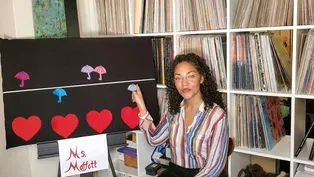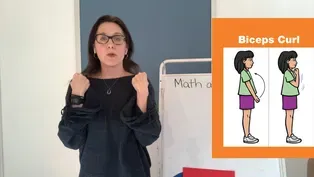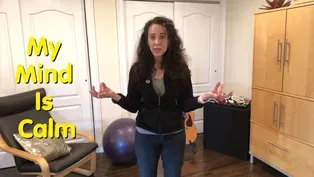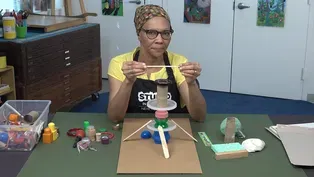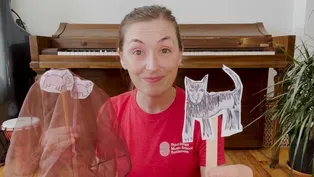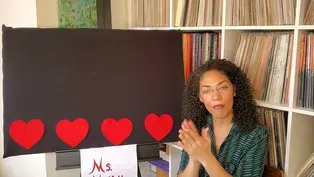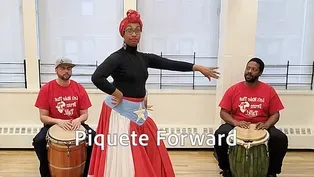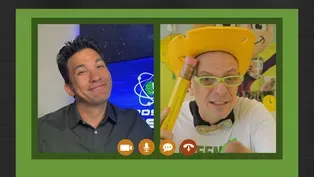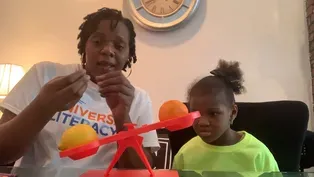
What Sounds Do You Hear in Kids?
1/25/2021 | 55m 16sVideo has Closed Captions
Launch balloon rockets, learn about shapes, read ESCARGOT.
Launch balloon rockets, learn about shapes, read ESCARGOT, blend and segment sounds, practice short i r, f, & final s. LET’S LEARN helps children ages 3-8 with at-home learning. One-hour programs feature instruction by educators and virtual field trips.
Problems with Closed Captions? Closed Captioning Feedback
Problems with Closed Captions? Closed Captioning Feedback
Let's Learn is a local public television program presented by THIRTEEN PBS

What Sounds Do You Hear in Kids?
1/25/2021 | 55m 16sVideo has Closed Captions
Launch balloon rockets, learn about shapes, read ESCARGOT, blend and segment sounds, practice short i r, f, & final s. LET’S LEARN helps children ages 3-8 with at-home learning. One-hour programs feature instruction by educators and virtual field trips.
Problems with Closed Captions? Closed Captioning Feedback
How to Watch Let's Learn
Let's Learn is available to stream on pbs.org and the free PBS App, available on iPhone, Apple TV, Android TV, Android smartphones, Amazon Fire TV, Amazon Fire Tablet, Roku, Samsung Smart TV, and Vizio.
Providing Support for PBS.org
Learn Moreabout PBS online sponsorshipMore from This Collection
Video has Closed Captions
Read SCHOOL BUS and draw one, learn about prefixes and pitch, build sculptures. (57m 48s)
Running and Counting Both End in “ing”!
Video has Closed Captions
Move to improve, find the missing number, learn songs from Ghana, read ABUELITA’S SECRET. (58m 17s)
What Sound Does “aw” Make in Draw?
Video has Closed Captions
Read a story, discover "au" and "aw," learn about density, count, and move with music. (56m 58s)
Can You Find the Short “u” in Subtract?
Video has Closed Captions
Help Super Grover 2.0 solve a prickly problem, read ALL THE WAYS TO BE SMART. (56m 19s)
What Sound Does “gl” Make in Glove?
Video has Closed Captions
Play the glockenspiel, help Super Grover 2.0 make a cart move, read TWO WOOL GLOVES. (58m 9s)
Incredible Starts with Short “i”!
Video has Closed Captions
Solve problems with Super Grover 2.0, catch a rainbow, hear a piano sound like a cuckoo. (56m 9s)
What’s the Sound of “oo” in Book?
Video has Closed Captions
Explore animals’ form and function, sing about the 3 little pigs, read THE LITTLE BOX. (58m 15s)
We’re Reducing, Reusing and Recycling!
Video has Closed Captions
Learn all about rhythm and the number 9, read A BAG IN THE WIND. (56m 17s)
Video has Closed Captions
Learn to dance bomba and grow food in a city, read WOLF CUB’S SONG. (55m 20s)
How Many Syllables are in Invent?
Video has Closed Captions
Invent your own instrument, make 10 to add numbers to 20, read ONE GOLDEN RULE AT SCHOOL. (57m 36s)
Video has Closed Captions
Learn about the science behind mind reading, count shells, read MY BIG FAMILY. (57m 27s)
Which is Heavier: One Apple or Two Apples?
Video has Closed Captions
Defy gravity, learn secret code words for fast and slow in music, read WHOOO KNEW? (58m 5s)
Providing Support for PBS.org
Learn Moreabout PBS online sponsorship- [Narrator] Ready to learn?
- Hi.
- Hi.
- [Narrator] It's time to share a story, [teacher shushes] read and write.
- Let's read it back.
- [Narrator] Discover science, sing, ♪ Somewhere ♪ play, and so much more.
- Cupcake!
- Very good.
- [Narrator] Stay tuned for lessons and activities.
- We're gonna start making some words, isn't that fun?
[gentle uplifting music] - [Narrator] Funding for this program was provided by the JPB Foundation.
[gentle uplifting music] - Hello scholars and families.
My name is Dr. Todd, I hope you are having a wonderful day.
I am delighted to be with you to read a favorite book of mine, and also we will do an art activity.
The title of this book is "Escargot", story by Dashka Slater, pictures by Sydney Hanson.
Let's take a look at the cover of the book, what do you see?
Correct, a snail.
Yes, the snail's wearing a striped shirt and a bandana.
Escargot is the French word for snail.
Everybody's say escargot.
Well done.
How many of you speak another language?
I speak very, very, very little French.
So let's get started with this read aloud.
Bonjour, that's hello in French.
I am Escargot.
I want only two things, to be your favorite animal, to get to the delicious salad at the end of this book.
Are you ready?
On your mark, get set, go.
Bonjour, I see you staring at me.
I don't mind.
My name is Escargot and I am such a beautiful French snail that everybody stares at me.
Right now, I am traveling to the salad at the end of this book.
It is a beautiful salad with croutons and a light in a vinaigrette.
A vinegarette is made with oil, vinegar, salt, and pepper and sometimes mustard.
It's a delicious salad dressing.
You should come, I just need a little push to help me start.
While we are traveling, we can talk.
Tell me, what do you think is my most beautiful part?
My shell, my neck, my tentacles?
Oh la la, it is so hard to choose.
That is because all of escargot is magnifique.
You can kiss me if you want.
Let's talk about our favorite animals.
Is yours the dog, the cat, the platypus, the wildebeest, the lemur, the hippopotamus, the snail?
Wait, before you answer, I must tell you something sad, so is that I might cry.
Will you stroke my shell just until I feel better?
Okay, now I will tell you the very sad thing.
Nobody ever says their favorite animal is the snail.
Perhaps you think snails are slimy.
Escargot, you are too slimy to be my favorite animal.
Au contraire, the trails I make as I travel to the salad are shimmery trails of, what would you call it?
Not slime, more like shimmery or shiny trails of shimmery stuff, but enough about me.
Do you also make a shimmery trail?
What is your favorite kind of salad?
You look like the kind of intelligent person who enjoys a salad with croutons and a light vinegarette and absolutely no carrots, the kind of person who might say, "My favorite animal is the snail."
Let's find out.
But perhaps you think, "Snails are shy, Escargot.
You are too shy to be my favorite animal."
Au contraire, I am quite fierce.
This is the face I make to stare a lion, or a wild boar or a carrot that sneaks into my salad.
Can you also make a fierce face to scare away the carrot?
Maybe we should roar at it too.
Let's try and making a fierce face, watch me.
Can yo make your fierce face?
Well done.
Let's try roaring, I'm gonna model first.
[instructor roars] You can roar now, one, two, three.
Well done, that was a very fierce face, and a very loud roar.
Do you want me to come out, really?
Then you must say, "Come out, Escargot.
Come out, and promise I will never put a carrot in your salad.
Come out and I will kiss you."
Here I am.
Don't forget my kiss.
I kiss you back.
[kiss smooches] Am I your favorite animal yet?
Perhaps you think, "Snails are slow, Escargot.
You are too slow to be my favorite animal."
Au contraire, I just don't like to hurry.
A French snail likes to relax before enjoying salads with a few croutons and a light vinaigrette.
But if I wanted to, I could run faster than the cheetah.
You don't believe me?
I will race you to the salad at the end of the book.
Who ever gets there first will be the fantastically fast champion of the world, and also your favorite animal.
On your mark, get set, go.
Do you see how fast I am?
I am like the wind itself.
I just need to rest for one second.
Can you blow on me to cool me off?
Okay, I am ready now for the final sprint.
Let's see what happens with Escargot.
I win, oh, you are here too?
A tie.
We are both the champions.
We are both magnifique.
Let us celebrate by eating salad with a few croutons and a light vinegarette.
Bon appetit.
That means good appetite in French, but this is not the right salad.
I wonder what's wrong with this salad?
This salad has a few croutons and a light vinegarette and carrots.
Look how big the author chose to write the words carrots.
Escargot doesn't like carrots.
Let's see what's gonna happen.
Escargot does not eat carrots.
Escargot has never eaten a carrot.
Escargot will now make a fierce face at the carrot.
The carrot is not running away.
Perhaps you would like to eat the carrot?
Go ahead, try it.
I will make you a deal.
If you will try it, I will try to, on the count of three, we will take a very, very, very small bite of the carrot.
One, two, three.
The carrot was actually delicious, so delicious that I've might have forgotten to share.
You probably won't choose me as your favorite animal now.
You will choose instead the baboon or the koala or the earwig, but that is okay, c'est la vie.
That means that's life in French.
I will tell you a secret, you are very beautiful even if you don't make a shimmery trail.
You are very fast, almost as fast as Escargot, and you can make a very fierce face.
Don't show me, I remember.
You are magnifique.
In fact, you are my favorite animal, and so I kiss you.
[kiss smooches] The end, I hope you enjoyed this book.
What was your favorite part of this book?
Okay, I love hearing your responses.
My favorite part was when Escargot made a fierce face and roared.
[roars] So wonderful job listening to this read aloud.
Now I'm going to tell you about the activity we're gonna be doing.
So for this activity, you just need some paper, markers, crayons, or pencils.
You could even do it on your computer if you want.
You could use paint.
So we're gonna think about our favorite animal.
My favorite animal is the tiger, so you think about your favorite animal.
I prepared this, it says my favorite animal.
You can have an adult write this.
If there's not an adult around, you can try to do your best to write this out, my favorite animal.
And then, you can think again about what is your favorite animal.
What I chose to do is I chose to print out a picture of a tiger.
As I said, my favorite animal is a tiger.
You can draw, paint, print out, whatever favorite animal you have.
Please remember to share your picture with a family member and/or a friend.
Hopefully, the next time you see a snail, you will think of Escargot.
You can also talk to your family about what you like in your salad.
Do you like salad?
What kind of salad dressing do you like?
It has been a pleasure being with you today.
I hope you have an amazing rest of the day, and I can't wait to see your amazing pictures.
This is Dr. Todd, goodbye for now.
- Hi movers and shakers, this is Violet, and it's time to get a little bit silly.
Are you ready for a song?
For this one, you're just gonna need to put your fingers up.
So let's wiggle our fingers, wiggle our bodies, and get ready.
♪ There were five in the bed and the little one said ♪ ♪ Roll over, roll over ♪ ♪ So they all rolled over and one fell out ♪ ♪ There were four in bed, and the little one said ♪ ♪ Roll over, roll over ♪ ♪ So the all over and one fell out ♪ ♪ There were three in the bed and the little one said ♪ ♪ Roll over, roll over ♪ ♪ So they all rolled over and one fell out ♪ How many are left?
One, two.
♪ There were two in the bed and the little one said ♪ ♪ Roll over, roll over ♪ ♪ So they over and one fell out ♪ How many are left?
♪ There's one in the bed and the little one said ♪ Ah, the whole thing's for me.
Have a good day.
[uplifting music] - Hello friends.
My name is Isabel, and welcome to my learning corner.
Today, you are going to have so much fun.
First, we're going to learn how to identify alliterations.
Alliterations are groups of words that all start with the same sound.
Then we're going to segment words into all the sounds we hear, blend sounds into words, use what we know about some of our very special letters of the day, the letter R that says [growls softly], the letter F that says [pronounces F], good job, the letter I that says, "Ih", and the letter S that, when it comes at the end of a word can say [buzzes].
Keep a close eye for that tricky S. We're going to build words with our special letters of the day, and we're going to use everything we've learned so far about letters and sounds in order to read words, and even sentences!
Are you ready?
[kids cheering] Great, let's go.
In our first set of activities, we are going to start with some phonemic awareness activities.
Those activities where we listen for the sounds we hear in words.
So before we even start, we've got a warm up our ears.
Are you ready?
[slide whistle whistles upward] Good, we're ready.
In our first activity we're going to identify alliterations.
In alliterations we have two or more words that all start with the same sound.
If you hear the same sound every time in every word then you're going to put a thumbs up.
If the sounds aren't all the same we're going to put two thumbs down, all right?
Let's try one together just to warm up.
Listen to this.
Is it an alliteration?
Warm winter coat.
That didn't sound right.
I heard wuh, warm, wuh, winter.
Those are good, but then I heard cuh, coat, no good.
Good job, now you're ready.
Listen to the next set of words and tell me if it's an alliteration by putting two thumbs up.
My marker.
Yes, yes, yes, yes, good job.
Okay, here's the next one.
Hmm, what will it be?
[gasps] Pink party hat.
I couldn't fool you, I couldn't fool you.
Here's the last one.
Super stinky sock.
Yes, good job Now we are going to listen to a word and break that word up into all the sounds we hear.
We call that segmenting.
Here's the first word, duck.
Take out your hands and we're going to make a chopper, and we're gonna chop out all the sounds we hear.
Duh, uh, cuh.
Good job, how 'bout another word?
Lamb.
Luh, ah, mm, lamb.
Are you ready for another one?
Fish.
Fuh, ih.
[shushes] Good job.
Here's our last one.
Leash.
Luh, ee.
[shushes] Good job!
Now we're going to take the sounds we hear and blend them together to make a word.
We're gonna take the sounds we hear and blend them together to make a word.
Are you ready?
Okay.
Mm, uh, guh.
Let's put it together.
Mug.
Huh, eh, n. Hen.
Cuh, ih, duh.
Kid, good job.
Now we're ready to build some words together.
Are you ready to build our first word?
[gasps] Of course you are.
Hmm, what does this word say?
[growls softly] Good.
Ih, rih.
Duh, rid.
Good job.
Let's build another word.
I'm going to keep this letter right here.
What sound does that make again?
Exactly, ih.
Now remember, we talked about how at the end of words the S might say [buzzes].
In this word the S says [buzzes].
What word do you think this is?
Let's sound it out.
Ih, [buzzes] is.
The word is is, good job.
I'm going to keep this I right here, and it's going to go in the middle of my new word.
Here's our last word to build today.
I bet you already know what this word is.
Let's tap it out together, are you ready?
[Isabel pronounces F] Ih, tuh.
[pronounces F] Ih, tuh.
Fit!
Fit!
Oh, great job guys.
Now we're going to use everything we know about letters and the sounds they make to read more words, and even sentences!
So now we're gonna take everything that we've learned about our special letters of the day and everything that you've been learning all week and everything that you've been learning all year to help us to read words and sentences.
So the first thing that I would like you to do is make sure that you're sounding out each letter before you put it together to make the word like this.
Ih, tuh, it.
You got it, let's go.
Ih, [pronounces F], if.
Ih, n, in.
Ih, [buzzes] is.
We just saw this word, and that tricky, tricky S. Ah, [buzzes] as.
[growls softly] Ah, n, ran.
[pronounces F] Ah, n, fan.
[pronounces F] Ih, n, fin.
[pronounces F] Ih, tuh, fit.
[pronounces F] Ah, tuh, fat.
Ah, n, an.
Ih, n, in.
Puh, ah, n, pan.
Puh, ih, n, pin.
Cuh, ah, n, can.
[pronounces F], ah, n, fan.
[pronounces F] [growls softly] This is tricky.
It's a name.
Ah, n, fruh, blend first, an, Fran.
Good job.
Tuh, ih, puh, tip.
Tuh, [growls softly], truh, ih, puh, trip.
Truh, ap, trap.
Good job.
Now we're ready to read our sentences, let's go.
A fana and a fin can fit.
Did Fin sit in the bin?
I am so proud of each and every one of you, friends.
Let's think about what we've learned today.
We've learned that an alliteration is a group of words that start with the same sound.
And we identified whether a group of words wasn't alliteration or whether it wasn't.
We segmented words into the sounds we heard.
We blended sounds into words.
We used what we knew about our special letters, R, F, I and the S that says [buzzes] at the end of words to read words and even sentences.
And trusted adults, you have a game that you can play with my friends any time.
Say a word, and have them tell you all the sounds they hear, or say all the sounds in word and have them tell you what the word is.
Fun, fun every time.
Don't forget, friends, go find a trusted adult as soon as this episode is over and show them everything you've learned.
You will impress everyone.
I can't wait to see you again, but until I do, make sure you enjoy every episode coming up.
Bye friends.
[gentle uplifting music] My name is Lily, and I'm so excited to be here with you today.
We've been home for a while, and some days when I wake up, I feel kind of sad.
But this morning I woke up feeling excited because I had such a cool dream last night.
And my dream made me think of my special geometry hat.
So I'm gonna call Omar because I know he has a hat too, and I think he'd like to hear about my dream.
Omar, Omar, Omar?
- Hi Lily.
- Hi Omar, how are you?
- Lily, I'm good.
Wait, you have on your geometry hat too.
- You know I do.
How are you feeling today?
- I'm feeling okay.
I have a lot of energy inside me, but feeling pretty good.
How are you doing?
- Same here.
I feel like I have so much energy I could burst, and I think it's because I had a really cool dream last night.
- Can you tell me about the exciting dream?
- You know I will.
I had a dream that somehow I was in the Metropolitan Museum of Art all by myself, and I got to walk through all the halls and look at all the paintings and I noticed a lot of shapes.
And then I went into the Egyptian room and you know that cool reflecting pool?
- Yeah.
- Well, somehow it miraculously filled with shapes and I got to swim through the shapes.
It was so much fun.
So then when I woke up in the morning I decided to search for paintings with shapes, and I found this one that I really like.
It makes me feel very calm and very peaceful.
What do you think about it, Omar?
- Yeah, the colors are really nice.
It makes me feel at ease.
I see though, in the middle, what are those shapes in the middle?
- Yeah, isn't it cool?
I think these shapes in the middle might be the same shape, but I have to do some investigating to figure out what types of shapes they are.
I know that they have one, two, three, four sides, but that's not enough to tell me what type of shape it is.
'Cause there's a lot of shapes with four sides, so let me look at the angle.
I see a right angle here and I see a right angle here, but these aren't right angles.
So if it doesn't have four right angles that means it can't be a rectangle.
So I'll have to look at something else.
I see that these sides are parallel, and these sides aren't parallel.
Omar, do you know what parallel is?
- I think parallel is when two sides are the same distance apart and never touch, like this.
- Exactly, Omar.
This is parallel.
So if these shapes have four sides and only one set of sides are parallel, that means it must be a trapezoid.
- I get it because it's a trapezoid.
Hey, I have an idea.
Let's play some geometry games.
- Let's do it.
- Let's warm up with the Same Shape game.
It's a quick one, so I'll show you how to do it.
I'll point to a shape on my geometry hat, which is broken now, but that's okay.
And then you point to the same shape on your geometry hat?
- Sounds fun.
Okay, I'm ready, Omar.
- Okay, let me point to the first shape.
How about this one?
Can you point to the same shape on your geometry hat?
Which of my shapes are the same shape as the one Omar is pointing to?
I think it's this one.
I think it's another trapezoid.
- Yes, it's another trapezoid.
Okay, okay, let's play one more round.
- Great.
- Can you find on your geometry hat, Lily, this shape?
- Hmm, I see couple.
I think this is the same, and I think this is the same.
- Yes, do you know what that shape is called Lily?
- Well, if it has four sides all the same length it must be a rhombus.
- Yes, it's a rhombus.
Good job Lily.
- Thanks Omar.
- Okay.
Now I think we're ready for another game called the I spy geometry game.
- Oo, fun.
So Omar, should I go get my spy glasses and detective hat?
- Silly Lily, you can, but we can also play it with what we have, we can use our hats.
- Sounds great!
- Okay, so I'm going to give you clues of a shape that I spy.
- Okay, like I spy a shape that is red.
- Well, if you're going to guess a type of shape, I should give clues that tell you more about what makes that shape, that shape.
In math we call it the shape's defining attributes.
- Okay, like I see a shape that's red and really big on your shape hat display.
- [chuckles] Yeah, well that does tell you something about one shape, but hmm.
Look at this, this circle is big and this circle is small, but they're both circles.
So does the size tell us that it's a circle?
- [laughs] No way Omar.
I know something is a circle if it's perfectly round.
- Exactly, exactly.
That's why we give clues that tell us about what makes a shape, okay?
- Oh, okay Omar.
- Ready to try?
- I am, maybe you give me a clue and then I'll figure it out.
- Okay, let's try it.
I spy on your hat, Lily, a that has three sides.
- What shape could it be?
Not this one.
What about this one, Omar?
A shape with three sides.
One, two, three.
- Yes, you're right.
A triangle has three straight sides.
But Lily, I see more than one triangle on your hat.
Let me give you another clue.
I spy on your hat a shape that has three sides and all three sides are the same length.
[Lily gasps] - I think that's this one, Omar.
These definitely look like these sides are all the same length.
- Yes, a triangle will all three sides the same length is a... - Equa, equal- - Equa... - Equilateral, yes!
- Equilateral triangle, yes.
Okay, do you want to try now?
- That was so fun.
- I definitely do.
- Okay.
- Let me see that.
Huh, I spy on your hat something that has four sides.
- So easy, it's this the rectangle on top.
Omar, you're right, that shape does have four sides, but it's not the shape I was thinking of.
The shape you pointed to is a rectangle, but the shape I'm spying is a special type of rectangle.
It's a special type of rectangle because it has four sides all the same length.
What could it be?
- Hm, well, I know.
Is it a square?
- Ding, ding ding, you're right, Omar, it is a square.
A square, just like a rectangle, has four sides and four right angles, but it's special because all the sides are the same length.
- [gasps] Lily, we should celebrate.
We should dance.
- Of course we should.
Okay, I'm ready.
- I have an idea though, before we dance.
I'll dance using straight lines and then you dance using curvy lines.
- I love it.
And join us, make your body into straight lines or curvy lines.
Okay, let me get my dance floor ready.
[delightful electronic music] Omar, it feels so fun to dance with you.
- Woo, I'm so happy we got to dance.
- It's so great to dance.
- If you want to play the I Spy Geometry game with a trusted adult or a sister or brother or cousin you may live with at home, remember the rules of the game, tell them you're gonna give them clues about a shape that you spy so they can guess it, and try to make the clues defining attributes of a shape.
Lily, can you remind us what are defining attributes of a shape?
- I know Omar because I was trying to say things like it's really big or the color, but instead you should focus on the things that make the shape that shape, like the number of sides or the type of angle.
Right, Omar?
- Exactly, now, you know the rules, go ahead and play.
- Right, now Omar, do people have to play with hats?
- No, you could talk about the shapes you see around you, and your trusted adult can help you identify them.
- Great, that's a good point, Omar, because sometimes I forget my shape names or things that make a shape a shape, so I can ask for help from my trusted adults.
- That's a great idea, Lily.
It's good to ask for help when you need it.
- Omar, it's so good, and it was so good to see you today.
Should we send each other a kiss through the air?
- Let's do it.
- Send the kiss to someone you love that you can't see right now.
Remember, math is all around you.
Go see what math you can find today.
Bye Omar.
- Bye Lily, by everyone.
[gentle uplifting music] - Hi everybody, I'm Nora, and today I'm going to show you how I like to be a scientist at home and how you can be one too.
I'm really excited today because we're gonna talk about one of my favorite things, outer space.
I thought it would be really cool to be an astronaut.
Do you know what an astronaut is?
An astronaut is someone who goes up into outer space to explore.
It's a really neat job because they get to build and play with machines, they get to learn all about other planets, and they get to do a lot of fun science experiments.
So, hmm, let's think.
I wonder how do astronauts get to outer space?
Do they take a car?
Do they walk?
Hm, no.
I don't think you can walk.
It's really, really far away.
Really hot up there above the sky.
Hmm, so how do they get there?
I know.
They take a rocket ship.
Okay, let's imagine that we're astronauts going into outer space in a rocket ship.
Can you close your eyes, and get ready to go into outer space?
Okay, the first thing I'm gonna do is I'm gonna fasten my seatbelt, safety first, and then I'm gonna get ready in my spaceship to take off.
We're gonna hear a countdown, can you count down with me?
10, nine, eight, seven, six, five, four, three, two, one, blast off.
[rocket engine roaring] Whoa, it's going really fast.
My rocket ship is a little bit shaky.
I'm going up past all the clouds and we're going out into space.
Oo, it's kind of dark in outer space.
[gasps] Hmm, what do you see in outer space?
I see a planet over there.
[lasers zipping] Oh wow, watch out!
That's a big asteroid on that side.
Hmm, hmm, I think I see a star.
[whooshing] Okay, it's time for us to come back down to Earth.
Can we land our rocket ships safely?
Whoa!
[exhales] [gasps] Okay, it's time to open your eyes.
Now let's draw a picture of what we observed when we were in outer space.
First, I'm gonna start with a big round planet.
I'm drawing a circle to be my big planet that I saw.
There's all sorts of different kinds of planets and outer space.
Some planets are big, some planets are kind of small.
Some planets are warm and some planets are cold.
I'm coloring this planet blue because blue is a color that makes me think of things that are cold, but you can color your planet whatever color you want it to.
There's lots of different planets that we can find in outer space.
[lighthearted music] Okay, what else did I see when I was imagining I was in outer space?
Oh, I saw an asteroid.
Do you know what an asteroid is?
An asteroid is a rock in outer space.
I'm going to draw some kind of wiggly edges on my rock.
And then what color are rocks that I find outside?
Hmm, sometimes they're kind of brownish.
So I'm gonna color my asteroid brown.
And the asteroid was moving really fast, so I'm gonna draw some lines to show that it was moving fast.
[lighthearted music] Okay, what else did I see?
Oh yeah, I saw a star and it was really far away, so it looked really small.
So I'm gonna draw a little star over here, and I'm gonna draw it yellow.
Do you know there's a star that we can see in the sky during the day?
That's right, the Sun is a star.
We can see lots of stars at night, but we can even see the sun during the day 'cause it's really close and really bright.
Okay, the last thing I'm gonna draw on my picture is my rocket ship.
So I'm gonna draw my rocket ship like this, and I'm gonna draw it gray, kind of silvery 'cause I like to imagine my rocket ship is made out of metal, so it's kind of silvery.
And I'm gonna make an engine on my rocket ship to make it move really fast throughout outer space.
[lighthearted music] Okay, I think I'm done with my picture of outer space.
There's just one last thing I want to do, and that is, I want to color in the background to be dark and black like it is an outer space.
Okay, so if I want to be an astronaut, I need a rocket ship.
Hmm, I don't have one at my house.
Do you have a rocket ship I could borrow?
No, oh well.
Maybe I could make a rocket ship out of some of the things that I do have at home.
And that can teach me a little more about how rocket ships work.
Let's see what I have.
Hmm, I have a balloon, a straw, hmm, and in long piece of string, woo!
Let's see, let's start with the balloon.
Now what do you do with a balloon?
You blow it up, of course.
Okay, I'm gonna try to blow up my balloon.
Okay, I blew some air into my balloon and now I'm holding the end tight.
So the air is trapped inside.
I wonder what do you think would happen if I let go?
Hm, should be test it and find out?
Okay, let's count down from three.
Three, two, one, blast off!
Whoa, what happened to my balloon?
I think that when I let go all of the air flew out of my balloon and pushed my balloon forward through the space.
Hmm, that looked kind of like a rocket.
I wonder if we can use that balloon to do a rocket experiment?
Let's try it.
The first step to make your balloon rocket is to thread the string through the straw, pulling it all the way through so the straw has string coming out both sides.
Next, tape one end of your string to someplace high, on the wall or on the back of a chair.
Then tape the other end of your string somewhere further away, on the other side of the room or on another chair.
Next, blow up your balloon.
You can get a grownup to help you blow up your balloon if you want.
Remember, you want to pinch the end of your balloon but not tie it, so that the air is stuck inside for now.
Finally, take your balloon and with the open end facing the wall where you taped the end, attach your balloon to your straw, just on the top like this.
Okay, now I'm ready to blast my balloon rocket through outer space.
I'm gonna pretend that this wall is the Earth, where we are, and that over there on that wall is the moon.
Let's see if we can get our balloon rocket all the way to the moon with the air that I put in it.
Are you ready?
Okay, blast off in three, two, one, blast off!
Oh, it almost made it.
Hmm, maybe it needs a little more power.
I wonder if it needs a little more air.
Okay, I'm ready to try again.
Let's see what happens this time.
I'm gonna let go on the count of three.
One, two, three.
[gasps] We did it, our rocket made it all the way to the moon.
Hmm, I wonder what would happen if I put less air in my balloon.
Do you think that would change how far or how fast it would go?
What else could I change?
I could see what would happen if I used a different kind of string, or maybe if I moved the string around and I put the earth really high up and the other planet really low.
Or if I put them really far apart, do you think my balloon rocket could go all the way across the room?
What about all the way down the hall?
There are lots of things that we can test with our balloon rockets.
I have some friends who were making some rockets today too.
Let's see what they found.
- It's me, Marcus.
- And it's me, Mommy, and we are here today about to do a- - A rocket ship.
- Rocket ship.
- And we're trying to make it go from the Earth to the Moon.
- Okay, cool.
You said that you wanted the earth to be your bed, and the moon is gonna be the wall, right?
- Yes.
- Okay, so we're gonna put the tape on one side on the bed, and then- - Then put it on another.
- Side, and then we're gonna use, so which one do you want to try first?
Do you want to try the paper towel holder or do you want to try to straw.
- The straw.
- Why do you want to try the straw?
- Because it's more lighter.
- It's lighter.
- We blew up the balloon and we got the tape on the wall.
- [Mommy] So now what are we about to do next?
- And now we're gonna tape it on there.
- Okay, so let's see.
Come on, so we have the straw here, and we're gonna tape, hold on.
Go ahead.
There you go, all right.
- Tape the balloon.
- [Mommy] So we're gonna see, on the count of three.
- You hold it right here.
- [Mommy] On the count of three you're gonna let it go, okay?
And we're gonna see how far it goes, ready?
- Yes.
- One, two, three.
- Two, three, zero!
- Go!
Oh, it almost made it all the way over.
- First, I blewed it up bigger this time for it to go to the end.
- [Mommy] So you're gonna see if it'll go all the way to the end?
'cause last time it went almost to the end, right?
- Yup.
- Okay, so again, you're gonna put it on.
Come on, put the tape on.
You're still blowing up the balloon, you're gonna pop it.
Oh my gosh, it's so big.
Come on, let's put it on.
All right.
- [grunts] Then it's gonna go over there.
- [Mommy] Let's see.
All right we're gonna do, you wanna do the countdown this time?
- Yup.
- Go ahead.
Ready?
- Three, two, one, zero!
- [Mommy] Yay!
We made it all the way to the end.
- Hello, I'm Harry.
And today, in my backyard I'm gonna try the balloon rocket experiment, and I'm gonna see what happens.
So I blew this balloon up as much as I could and I'm gonna see if I can get it to the end.
Three, two, one.
That was good.
This time I lowered the starting point and I'm gonna see if I can make it to the end.
Three, two, one.
- Woo!
- I'm gonna try it again, but with an action figure on it.
Three, two, one.
So I just got back and I tried three different ways.
The first way was when we had the yard almost straight.
The second one is when we lowered the starting point.
The third time is when we put an actual figure on the straw.
But the thing that I learned is that when it's almost fully blown up it goes pretty far, but when it's not fully blown up, it's not as blow up, it doesn't go that far.
And with the action figure, it didn't make it go as far.
And that's what I learned from the balloon rocket experiment.
Wow, those are some awesome rocket ships.
You and your family can make balloon rockets at home just like I did.
Or you can draw your own picture of what you imagined it would look like to take a rocket ship ride through outer space.
Maybe someday I'll get to go up into outer space in a rocket ship and I'll get to look down and see what earth, where we live looks like from way up high in space.
I think that would be pretty cool.
But for now, I'm just gonna do my own science experiments right at home where we are.
Thanks for joining me.
And remember, that you can be a scientist at home every day if you stop to notice and wonder about the world around you.
Bye.
[gentle uplifting music] - Hi, my name is Margaret, and I want to talk to you about feelings.
We all have feelings and they come in different sizes just like our clothes and our shoes do.
Let me tell you what I mean.
We can be a little bit sad when we can't wear our favorite shirt.
We can be a little bit sadder when we can't play with our favorite toy because it's broken.
And the biggest and saddest feeling can be when we miss someone that we love, and that's okay.
We all have these big feelings, these big sad feelings.
You do, and me too.
When I feel sad, a big sad, I'm not happy, I'm not smiling, and I'm crying.
But what makes me feel better is taking my favorite teddy bear, just like this one.
And I give him a big squeeze, just like this.
I hug him tight.
That feels really good.
I feel happy now.
How do you feel?
I hope this helps.
Funding for this program was provided by the JPB foundation.
[gentle uplifting music] [orchestral music]
Let's Learn is a local public television program presented by THIRTEEN PBS
